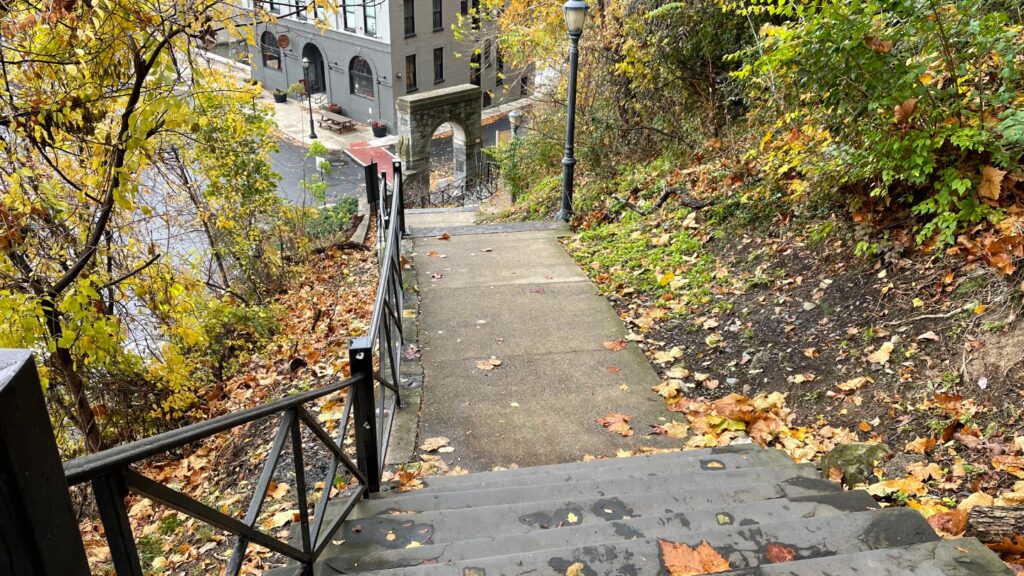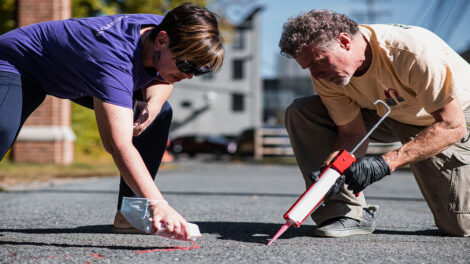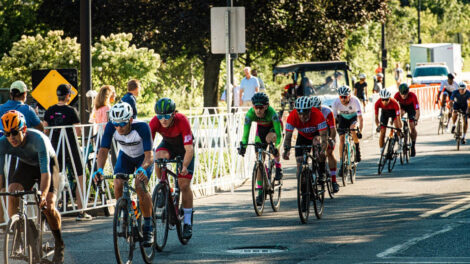Lafayette Receives Funding to Create Pedestrian-Friendly Trail
By Bryan Hay
Lafayette College has received state funding to build a public multimodal trail that will provide a safe, accessible route linking the College Hill neighborhood and Lafayette’s hilltop campus with downtown Easton.
On Nov. 19, the Commonwealth Financing Authority (CFA) approved Lafayette’s request for an $869,694 grant to create a multi-use trail that will extend diagonally across the escarpment from behind the William E. Simon Center for Economics and Business to the Karl Stirner trailhead at North Third Street.
Lafayette College has committed a 30% match, or $372,726, toward the grant for a project total of $1,242,422. The CFA is an independent state agency established to administer Pennsylvania’s economic stimulus packages.

Lafayette is proposing a new connection point with its historic stairs that will head southwest toward Bushkill Drive.
The trail for public use will link an existing parking lot along South College Drive on the east end of campus to the midpoint of the staircase that connects the main campus with the Williams Art Campus and downtown Easton, and will continue onto the Karl Stirner trail, intersecting the steps along the way.
“This public-private partnership, working in close cooperation with the City of Easton and Mayor Salvatore J. Panto Jr., to create a trail connecting the College Hill neighborhood and Lafayette’s campus with the Karl Stirner Arts Trail and the College’s Williams Arts Campus will make it easier and safer for residents, visitors, and students to walk or bike between downtown and our hilltop campus,” said Lafayette President Nicole Farmer Hurd.
The project complements Lafayette’s previous partnership with the state to fund forthcoming improvements to the historic stairs that connect College Hill and North Third Street, she said.
“Both of these projects will strengthen Lafayette’s connections with the broader community, help reduce carbon emissions from vehicles, make the city’s neighborhoods more attractive and accessible, and support economic and tourism activity,” Hurd added. “We want to thank Sen. Lisa Boscola and Rep. Bob Freeman for their instrumental roles in securing this funding.”
For pedestrians and bicyclists, the paved trail will be constructed north of College Avenue at the 150-foot vertical drop between Lafayette College’s campus and the downtown. It will have a distinct start and end but is designed to easily connect to additional pedestrian and bicycle networks on other areas of campus and the College Hill neighborhood.
Site amenities along the trail will include benches, bike racks, trash receptacles, handrails, and pedestrian lighting.
Lafayette is proposing a new connection point with the stairs that will head southwest toward Bushkill Drive. The trail will end at the bottom of the escarpment on Bushkill Drive, providing a direct link to the Karl Stirner Arts Trail. The multi-use trail also will include an area designated for exhibiting artwork, creating an opportunity for the project to serve as an extension of the Karl Stirner Arts Trail.
Construction of the trail is anticipated between fall 2022 and the end of 2023.
Lafayette’s multimodal trail is one of six transportation and park/trail projects in the Lehigh Valley that received funding through the Multimodal Transportation Fund Program and the Greenways, Trails, and Recreation Program.


2 Comments
Will this plan also consider a reconditioning of the existing stairs and path to make them more accessible to a broad range of users, particularly in the winter months?
Thank you for your question. The rehabilitation of the historic steps is already funded with a separate state grant. Work will complement the new trail for which funding was recently approved. While the site constraints preclude full ADA compliance, our aim, as much as is feasible, is to increase safety and accessibility for all users as a public amenity. We will do this by repairing the entire infrastructure, reducing steps where possible, lowering the grading, adding handrails, improving lighting, and installing places to rest and enjoy the view. Installation of a heating system will facilitate maintenance and keep the path open during the winter.
Comments are closed.